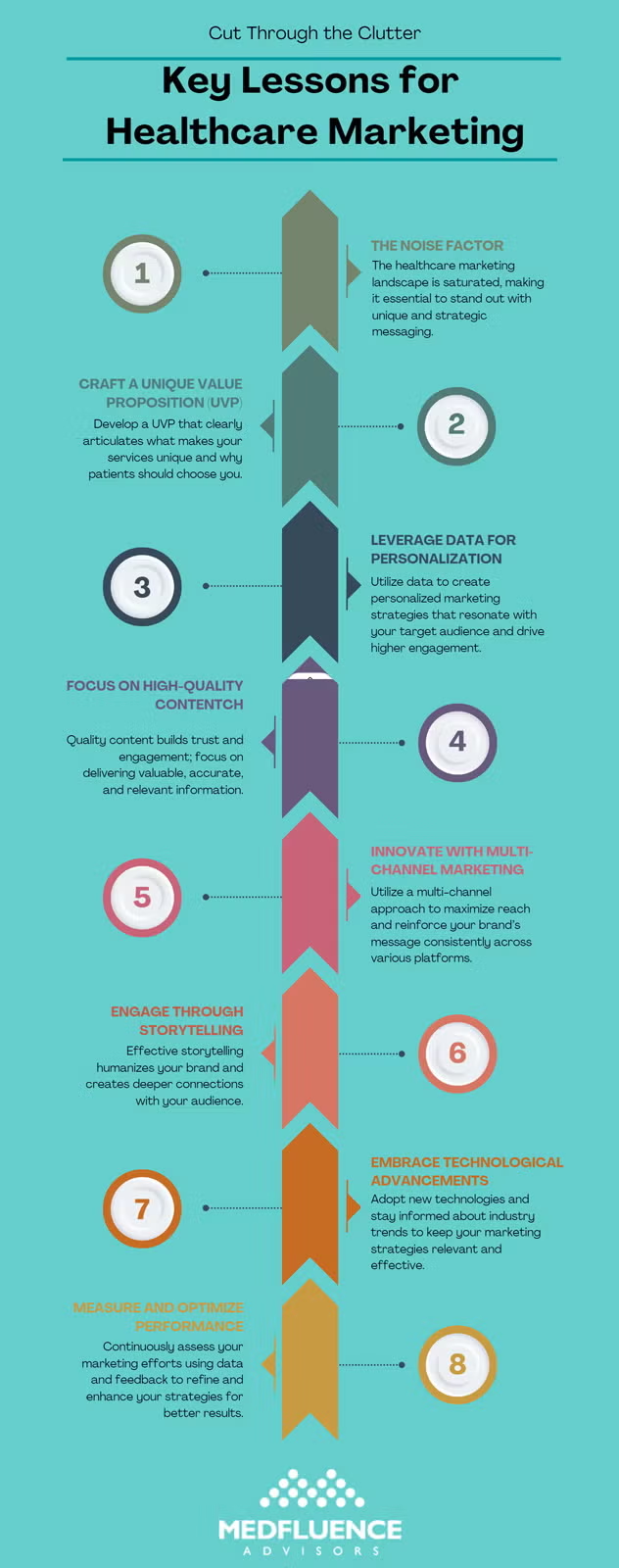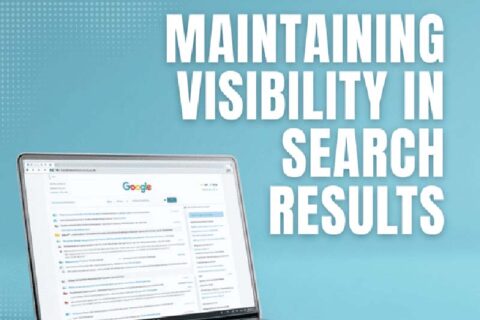10,000 Marketing Pieces a Day: How to Rise Above the Noise

In today’s fast-paced digital world, the sheer volume of marketing content is staggering. Every day, healthcare organizations, pharmaceutical companies, and medical practices flood the market with an estimated 10,000 pieces of marketing material, all vying for the attention of the same audience.
From social media posts and email campaigns to blog articles and video ads, the noise is overwhelming. For healthcare marketers, standing out in this crowded space has never been more challenging—or more crucial. The stakes are high. If your marketing efforts blend into the background, you risk being overlooked by potential patients and clients who are already bombarded with endless choices.
On the other hand, a well-crafted, strategically positioned message can cut through the clutter, resonate with your target audience, and ultimately drive meaningful engagement. This is the art of rising above the noise—crafting marketing strategies that not only capture attention but also build lasting connections in a world saturated with content.
By the end of this article, you’ll have a roadmap to ensure your marketing efforts stand out and thrive in an increasingly crowded field.
Understanding the Saturated Landscape
The healthcare marketing landscape is more crowded than ever, with organizations of all sizes competing to capture the attention of patients, healthcare professionals, and other key stakeholders. To rise above this saturation, it’s essential to first understand the scope and nature of the content flooding the market and why standing out has become such a formidable challenge.
Current Trends in Medical Marketing

The digital revolution has democratized content creation, allowing even the smallest medical practices to launch sophisticated marketing campaigns. This democratization has led to a proliferation of marketing materials across various platforms. Social media, email, search engine optimization (SEO), pay-per-click (PPC) advertising, and content marketing are just a few of the channels being leveraged simultaneously. The result is an avalanche of content that inundates the market daily.
Recent studies highlight this trend, showing that healthcare marketers are increasingly investing in digital marketing strategies, with significant growth in the use of video content, social media ads, and personalized email campaigns. However, as more players enter the field, the volume of content increases, leading to a situation where the audience is overwhelmed, and individual messages struggle to stand out.
Identifying the Noise Sources
Understanding the sources of this saturation is crucial for developing strategies to overcome it. The “noise” in healthcare marketing comes from a variety of channels:
- Social Media: Platforms like Facebook, Instagram, and LinkedIn are inundated with posts, ads, and videos from healthcare providers, all aiming to capture user attention in a few short seconds.
- Email Campaigns: Patients and professionals alike receive a constant stream of newsletters, promotional offers, and updates, often leading to email fatigue and lower engagement rates.
- Content Marketing: The emphasis on SEO has led to an explosion of blog posts, articles, and white papers, many of which offer similar insights and fail to differentiate themselves.
- Paid Advertising: PPC and display ads are everywhere, from Google search results to banner ads on medical news websites, further contributing to the clutter.
The saturation isn’t just about volume—it’s also about the homogeneity of the content. Many healthcare organizations are using the same strategies, discussing similar topics, and presenting content in familiar formats. This lack of differentiation makes it even more difficult for any one piece of marketing material to capture the audience’s attention.
To break through this noise, it’s essential to move beyond the conventional tactics and adopt a more innovative, patient-centric approach. This involves not only understanding the crowded landscape but also identifying what your specific audience truly needs and how to deliver that in a way that stands out.

Here are the essential strategies to define your unique value proposition (UVP), segment your audience, and craft personalized, impactful marketing efforts:
1. Defining a Clear and Unique Value Proposition (Uvp)
Your UVP is the cornerstone of your marketing strategy, articulating what makes your medical services or products unique and why patients should choose you. It’s not just about being different—it’s about being meaningfully different in a way that resonates with your target audience’s needs.
- Identify Core Strengths: Start by identifying what your practice excels at—whether it’s advanced technology, specialized expertise, or exceptional patient care.
- Understand Competitors: Analyze your competition to identify gaps and opportunities for differentiation.
- Highlight Patient Benefits: Focus on the tangible benefits your patients will experience, such as faster recovery times or personalized care.
- Incorporate Feedback: Use patient insights to refine your UVP and ensure it aligns with real-world needs.
- Keep It Simple: Your UVP should be concise, clear, and easily communicated.
Aligning UVP with Patient Needs and Preferences
A successful UVP aligns with the specific needs and preferences of your patients, ensuring it resonates deeply with your target audience.
- Research Patient Pain Points: Conduct research to understand the primary concerns and desires of your patients.
- Tailor to Segments: Adjust your UVP to cater to different patient segments, ensuring relevance across various demographics.
- Evolve with Expectations: Regularly update your UVP to stay aligned with changing patient expectations and market trends.
Communicating the UVP Effectively
Your UVP should be consistently integrated across all marketing channels, ensuring that every piece of communication reinforces your unique position.
- Integrate Across Channels: Ensure your UVP is prominent on your website, social media, and printed materials.
- Maintain Consistency: Consistent messaging across all platforms builds trust and strengthens your brand identity.
- Train Your Team: Ensure all team members can articulate your UVP, ensuring consistency in patient interactions.
2. Deep Audience Segmentation and Persona Development
Understanding your audience is crucial for effective marketing. By segmenting your target market and creating detailed buyer personas, you can tailor your strategies to meet the specific needs and preferences of different patient groups.
Segmenting Your Audience
- Demographic Segmentation: Categorize your audience based on age, gender, income, and education to address specific healthcare needs.
- Geographic Segmentation: Tailor strategies based on the location of your audience, considering urban versus rural needs.
- Behavioral Segmentation: Analyze patient behavior to identify engagement patterns and tailor marketing tactics.
- Psychographic Segmentation: Understand the lifestyles, values, and motivations of your audience to craft emotionally resonant messages.
Creating Detailed Buyer Personas
- Develop Comprehensive Profiles: Create personas with demographic, behavioral, and psychographic details.
- Persona Scenarios: Develop scenarios that represent each persona’s healthcare journey to humanize your marketing strategies.
- Persona Goals and Challenges: Identify the goals and challenges each persona faces to position your services as solutions.
Utilizing Personas
- Content Creation: Use personas to guide the creation of tailored content that addresses specific concerns.
- Channel Selection: Determine the most effective communication channels for each persona.
- Personalized Messaging: Customize messages to resonate with each persona, driving higher engagement and conversions.
By clearly defining your UVP and deeply understanding your audience, you can create targeted marketing strategies that stand out and effectively connect with your patients. This personalized approach not only enhances the patient experience but also strengthens your brand’s position in a competitive market.
3. Leveraging Data-Driven Insights
Importance of Data in Modern Marketing
Data is the backbone of modern marketing, providing insights into market trends, patient behaviors, and the effectiveness of campaigns. With data, you can make informed decisions, tailor your strategies, and stay competitive in a dynamic healthcare landscape.
Implementing Data Analytics Tools
There are various tools available for data collection and analysis, such as Google Analytics, CRM systems, and healthcare-specific analytics platforms. These tools help you track key metrics, understand patient journeys, and identify trends. Interpreting this data is crucial for making informed decisions, from refining your marketing tactics to optimizing patient engagement.
Personalizing Marketing Efforts with Data
By analyzing data, you can create personalized messages and offers tailored to different patient segments. This customization enhances patient experiences, making your marketing efforts more effective and driving higher engagement and conversion rates.
3. Crafting High-Quality, Relevant Content
Prioritizing Quality Over Quantity
In healthcare marketing, high-quality content is essential for building trust and engaging your audience. Rather than overwhelming your audience with volume, focus on producing well-researched, valuable content that meets their needs and interests.
Content Types That Resonate in Healthcare
Content that resonates includes educational articles, patient testimonials, case studies, infographics, videos, and webinars. These formats not only inform but also build credibility and foster connections with your audience.
Ensuring Content Relevance and Accuracy
It’s critical to provide up-to-date, evidence-based information in all your content. Collaborate with medical professionals to ensure accuracy, as this is vital for maintaining trust and authority in the healthcare field.
4. Embracing Personalization and Customization
Personalized Marketing Strategies
Personalized marketing strategies involve delivering tailored experiences to patients based on their specific needs and preferences. This can include customized emails, targeted social media ads, or personalized website experiences.
Tools for Customization at Scale
Marketing automation platforms, CRM systems, and personalization software allow you to scale your efforts, delivering personalized content and experiences to large patient groups without losing the personal touch.
Benefits of Personalization in Healthcare Marketing
Personalization leads to increased engagement, patient satisfaction, and higher conversion rates. By addressing individual patient needs, you create stronger, more meaningful connections, which can significantly improve outcomes.
5. Utilizing Multi-Channel Marketing Effectively
Diversifying Marketing Channels
Effective marketing involves leveraging various channels, such as email, social media, SEO, PPC, content marketing, and webinars. Each channel offers unique opportunities to reach and engage with different segments of your audience.
Coordinating Cross-Channel Strategies
Ensure that your messaging and branding are consistent across all platforms. Coordinating your strategies across channels helps reinforce your UVP and creates a cohesive experience for your audience.
Maximizing Reach and Engagement
Optimize each channel’s potential by tailoring your content and approach to the platform. Integrate efforts across channels to maximize your reach, engagement, and overall impact.
6. Engaging Through Storytelling
The Power of Storytelling in Healthcare
Storytelling can humanize your brand, creating emotional connections with your audience. Through compelling narratives, you can make complex healthcare information more relatable and engaging.
Elements of Compelling Stories
Key elements of effective stories include authenticity, relatability, emotional appeal, and clear messaging. These components help build trust and foster a deeper connection with your audience.
Implementing Storytelling Techniques
Use patient success stories, behind-the-scenes looks, and staff spotlights to illustrate your brand’s values and impact. These stories not only engage but also inspire and motivate your audience.
7. Innovating and Staying Ahead of the Curve
Embracing Technological Advancements
Incorporate emerging technologies like AI, VR, and telemedicine into your marketing strategies. These tools can enhance patient experiences and keep your brand at the forefront of innovation.
Staying Informed on Industry Trends
Continuously learn and adapt to new trends and best practices in healthcare marketing. Staying informed helps you remain competitive and responsive to changes in the market.
Fostering a Culture of Innovation
Encourage creativity and experimentation within your marketing team. A culture of innovation drives new ideas and approaches, helping your brand stay ahead of the curve.
8. Measuring Success and Continuously Improving
Identifying Key Performance Indicators (KPIs)
Track key metrics such as engagement rates, conversion rates, and ROI to measure the effectiveness of your marketing efforts. These KPIs provide valuable insights into what’s working and what needs improvement.
Regular Performance Reviews
Establish a process for regularly reviewing your marketing performance. Ongoing assessment helps you identify trends, recognize areas for improvement, and ensure your strategies remain effective.
Adapting Strategies Based on Insights
Use data and feedback to refine and optimize your marketing strategies. Continuous improvement is essential for staying competitive and responsive to patient needs.
A/B Testing and Experimentation
Implement A/B testing to determine the most effective tactics and messages. Experimentation allows you to fine-tune your approach and maximize the impact of your marketing efforts.
Transform Your Healthcare Marketing Today: Define, Segment, and Connect for Unmatched Success

In a crowded healthcare marketplace, standing out is not just a matter of being seen—it’s about being remembered for what truly sets you apart. Defining a distinctive and resonant unique value proposition (UVP) is the foundation of this effort, allowing you to clearly communicate the unique benefits your services bring to patients’ lives. By coupling this with deep audience segmentation and the creation of precise personas, your marketing efforts become laser-focused, speaking directly to the needs and desires of your target patients.
This strategic alignment not only enhances your practice’s visibility but also builds meaningful connections that transform one-time patients into loyal advocates. As the landscape of patient expectations and healthcare demands continues to shift, your ability to adapt and personalize your approach will be the key to not just surviving the noise but rising above it. By committing to a patient-centered, data-driven marketing strategy, your brand can carve out a lasting and impactful presence in the healthcare industry, ultimately driving growth, trust, and enduring success.
For more insights and strategies, click on our blogs and resources to learn how you can elevate your practice.


